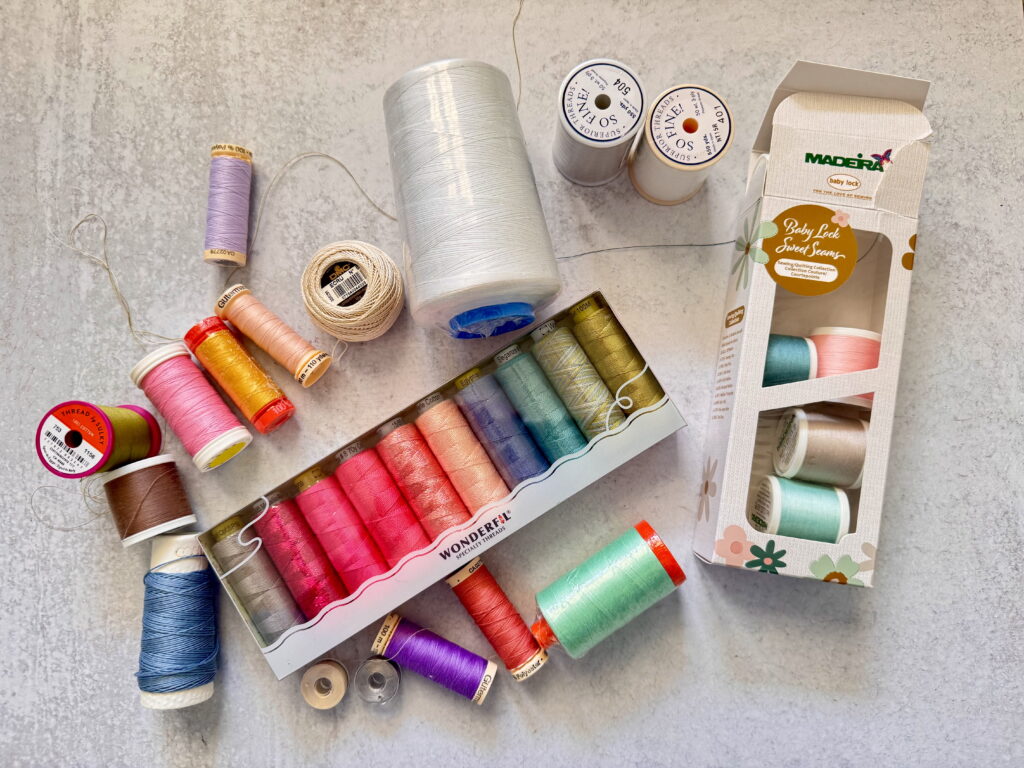If you’ve ever walked into a quilt shop and wondered why there are so many different threads—and what those numbers on the spool mean—you’re not alone! Thread weight plays a huge role in how your quilt looks, feels, and holds up over time. Choosing the right thread can make piecing smoother, quilting more striking, and appliqué almost invisible.
In this post, we’ll break down the most common quilting thread weights and explain why quilters choose one weight over another.

What Does Thread Weight Mean?
Thread weight refers to the thickness of the thread. Here’s the rule of thumb:
👉 The lower the number, the thicker the thread.
👉 The higher the number, the finer the thread.
This means a 30 wt thread is much thicker and bolder than an 80 wt thread.
You can see in the photo below. The thicker thread is 30 weight, and the thinner thread is 50 weight.
Why Thicker Thread = Smaller Number
Thread “weight” is not the same as fabric weight. In most thread systems, weight is based on length per unit of weight.
A 50 wt thread means that it takes 50 kilometers of that thread to weigh 1 kilogram.
A 30 wt thread means it only takes 30 kilometers of that thread to weigh 1 kilogram.
So, the smaller the number, the fewer kilometers it takes to reach that weight—meaning the thread is thicker.
Common Thread Weights for Quilting
Here are the thread weights most commonly used in quilting, with 50 wt standing out as the industry favorite.
8 or 12 wt.
Commonly used for big stitch hand quilting and binding.
Creates a bold, textured look where the stitches become a visible design element.
- Used for binding to give a big stitch look.
30 wt Thread
Thick, strong, and eye-catching.
Creates bold, visible quilting stitches.
Great for topstitching, decorative quilting, or when you want stitches to stand out.
40 wt Thread
Slightly finer than 30 wt but still noticeable.
A favorite for machine quilting and embroidery.
Balances visibility and smooth stitching.
50 wt Thread
The most versatile thread weight.
Commonly used for both piecing and quilting.
Smooth and strong without being too bulky.
Blends well while still holding seams securely.
60 wt Thread
Finer and lighter.
Ideal for detailed piecing and appliqué.
Reduces bulk in seams, especially useful for intricate quilt blocks.
80 wt (and finer)
Very delicate and almost invisible in fabric.
Perfect for hand appliqué, invisible machine appliqué, or fine quilting details.
Stitches disappear, allowing fabric and design to shine.
The photos below compare Pearl Cotton thread in 8 wt with 50 wt quilting thread (both cotton and polyester). Pearl Cotton is a thicker option often used for big-stitch hand quilting, while 50 wt thread is the most common choice for piecing and machine quilting.
Why Quilters Use Different Thread Weights
Why not stick with just one thread weight? Here’s why quilters change it up:
Visual Effect – Thicker threads create bold designs, thinner threads blend in.
Seam Bulk – Finer threads reduce thickness in seams.
Durability – Heavier threads are ideal for quilts that will be washed often.
Detail Work – Finer threads are perfect for intricate designs and appliqué.
Personal Preference – Some quilters love the look of bold stitching, while others want their quilting to disappear into the fabric.
Choosing the Right Thread Weight for Your Quilt
Here’s a quick cheat sheet:
- Want big stitch binding or hand quilting? → 8 wt or 12 wt.
- Want bold, visible quilting? → 30 or 40 wt.
- Want all-purpose piecing + quilting? → 50 wt.
- Want flat seams or invisible appliqué? → 60–80 wt.
At the end of the day, the “best” thread is the one that gives you the look and feel you want for your quilt. Don’t be afraid to experiment with different weights until you find your favorites!
MORE BLOG POSTS LIKE THIS
Now that you know more about different thread weights, here are some blog posts that can help you put your new skills and knowledge to the test!